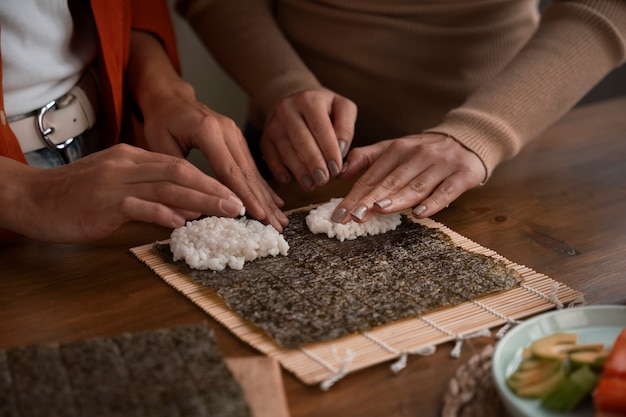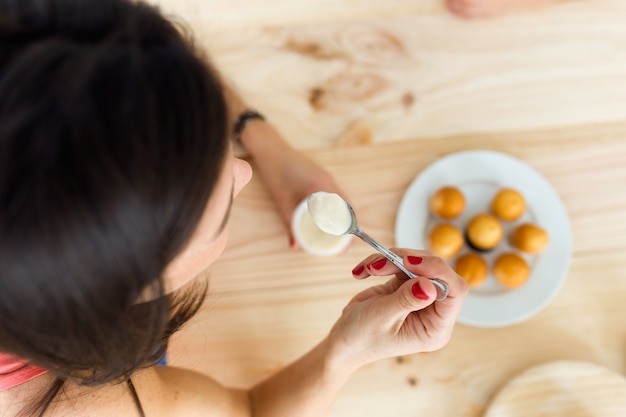tapioca pearls – those delightful little chewy balls – are the stars of many a dessert, from creamy puddings to refreshing bubble tea. But let's be honest, cooking tapioca pearls can seem a bit daunting. Especially when it comes to the smaller pearls, which are known for being a tad more temperamental.
Fear not, my fellow tapioca enthusiasts! I've been on this tapioca journey for years, and I've learned a thing or two about getting those little pearls just right. It's all about patience, a touch of know-how, and a sprinkle of culinary magic. Join me as we delve into the world of small tapioca pearls and discover the secrets to achieving perfect, chewy, and utterly irresistible results.
Part 1: Getting Started

1. Choosing Your Tapioca Pearls: The Foundation of Flavor
The first step on this culinary adventure is picking the right tapioca pearls. And when it comes to small pearls, a little extra attention is needed. They're generally labelled as "small tapioca pearls" or "boba," and they come in a range of brands and even colours. Personally, I find the smaller pearls more versatile – they cook faster, resulting in a softer, chewier texture that I find more enjoyable.
Now, I've tried a fair share of brands over the years, and honestly, the brand itself isn't the most crucial factor. What really matters is the size of the pearls. However, do check the packaging carefully for any signs of damage or moisture. You want those pearls to be dry and firm. Plus, if the packaging mentions the cooking time, that's a bonus – it saves you some trial and error.
2. Prepping Your Pearls: Setting the Stage for Cooking
Alright, so your pearls are chosen. Now it's time for a good soak. This is an essential step, one that helps soften the pearls and prepares them for their transformation into delicious chewiness. I start by rinsing them under cold water for a couple of minutes, making sure to wash away any lingering dust. Then, I transfer them to a bowl filled with cold water, ensuring they're completely submerged.
The soaking time can vary depending on the brand and the size of your pearls, but I usually let them sit for at least 30 minutes. While they're soaking, I get my cooking pot ready. I prefer a stainless steel saucepan with a lid – it allows me to keep a close eye on those pearls and helps prevent them from sticking to the bottom (a culinary crime I've witnessed too many times).
3. The Importance of Ratio: A Harmony of Water and Pearls
Now, this is where things get a little more scientific. The ratio of water to tapioca pearls is the key to achieving perfect texture. It's the delicate balance that ensures those pearls cook evenly and don't end up either too hard or too mushy.
The general rule of thumb is a 1:10 ratio. For every 1 cup of tapioca pearls, you use 10 cups of water. It sounds like a lot of water, but trust me, it's crucial to give the pearls enough space to cook without overcrowding.
Some recipes might suggest different ratios, and you're welcome to experiment. But I've always stuck to the 1:10 ratio, and it's never let me down. It's like the golden ratio of tapioca cooking.
Part 2: The Cooking Process

4. Bringing the Water to a Boil: A Symphony of Heat and Time
Okay, time to start the cooking process. Pour your pre-soaked pearls into the saucepan, along with the generous amount of water. Now, crank up the heat to medium-high, and let that water come to a rolling boil. I usually keep the heat high initially to get the water boiling quickly, then reduce it to medium-high to maintain a steady boil throughout the cooking process.
This is where patience truly shines. The boiling process is crucial. It's how those tapioca pearls transform from simple, translucent balls into the chewy, delightful morsels we love. So, relax, keep an eye on the pot, and let them simmer in their water bath.
5. The Art of Stirring: Preventing Stickiness and Clumping
Once the water starts to boil, you need to become a stirring maestro. Regular stirring is essential to prevent the pearls from sticking together and forming those dreaded clumps. I always reach for a trusty wooden spoon – it's gentle on the pearls and helps distribute the heat evenly.
Stir those pearls every few minutes. It doesn't have to be constant, but consistent stirring, especially during the initial boiling stages, is crucial to maintaining those pearls' individualistic charm.
6. The First Appearance: A Visual Transformation
As the pearls cook, you'll start to witness their transformation. They'll become more translucent, losing their initial opaque white color. You'll also notice them softening, becoming slightly chewy and inviting.
This stage usually takes about 10 to 15 minutes, but again, the cooking time can vary depending on the brand and size of your pearls. Keep a watchful eye on them.
Part 3: The Finishing Touches

7. The Taste Test: The Moment of Truth
Now comes the exciting part: the taste test. Grab a spoon, scoop out a few pearls, and give them a try. They should be soft and chewy, but still retain a slight firmness. If they're still hard or crunchy, they need a little more time in the boiling water.
I always make sure to sample a few pearls at different points during the cooking process. It helps me judge their progress and ensures they're cooking evenly. Plus, it's a delicious way to keep track of their transformation.
8. The Cooling Down Process: A Gentle Transition
Once you're satisfied with the texture of your pearls, take the saucepan off the heat. Let them rest in the hot water for a few minutes, allowing them to continue cooking and reach their full potential. I usually let them sit for about 5 minutes.
After their brief rest, drain the pearls in a colander. Then, give them a good rinse with cold water to stop the cooking process and prevent them from sticking together.
Part 4: Using Your Tapioca Pearls
9. The Sweetness of Success: Adding Flavor and Fun
Now comes the moment you've been waiting for: adding your favorite flavors. I love the simple sweetness of sugar, the creamy richness of milk, or a touch of vanilla extract. But the possibilities are truly endless!
You can incorporate your cooked pearls into a variety of desserts, from classic puddings and creamy cakes to even ice cream. But for me, the ultimate tapioca pearl experience is bubble tea. It's the perfect blend of sweet, chewy, and refreshing, and those tapioca pearls add a delightful textural element that elevates every sip.
10. Creative Combinations: Exploring the World of Flavors
Tapioca pearls are a blank canvas for your culinary creativity. Don't be afraid to experiment with different flavors and combinations. Fruits like mango and strawberry add a burst of sweetness, while a touch of matcha brings a hint of earthy elegance. Even chocolate and coffee can be incorporated for a more indulgent experience.
The key is to have fun and explore the vast world of tapioca pearl possibilities. You might even discover your new favorite flavor combinations.
Part 5: Storing Your Cooked Pearls
11. Proper Storage for Maximum Freshness: Keeping those Pearls Delicious
If you have any leftover cooked tapioca pearls, fear not! You can store them in the refrigerator for up to 3 days, preserving their chewy goodness. Simply rinse them in cold water and drain them well. Then, store them in an airtight container.
I usually store mine in a small Tupperware container, and they stay fresh for at least a couple of days. Just remember to give them a good stir before using them again, as they can stick together if not properly mixed.
Part 6: Troubleshooting Common Issues
12. Troubleshooting: Addressing Common Cooking Challenges
Cooking tapioca pearls, while straightforward, can sometimes present a few challenges. But don't fret! With a little know-how, you can overcome these common issues and achieve perfect pearls every time.
12.1. Hard Pearls: Not Enough Cooking Time
If your pearls are still hard after cooking, they haven't cooked long enough. Don't despair! Simply add more water to the saucepan, bring it back to a boil, and let those pearls cook for a few more minutes. Keep checking them until they reach your desired texture.
12.2. Mushy Pearls: Overcooked Pearls
On the other hand, if your pearls are too mushy, you've overcooked them. It happens to the best of us. But there's a simple solution. Drain the pearls and rinse them with cold water. This will stop the cooking process and help firm up those overcooked pearls a bit.
12.3. Clumpy Pearls: Sticking and Clogging
If your pearls are sticking together and forming clumps, it's likely due to insufficient stirring during the cooking process. Remember, those pearls need to move around freely in the water. Make sure to stir those pearls every few minutes to prevent them from sticking together.
Part 7: FAQ
13. Frequently Asked Questions
Now, I know you might have some burning questions about tapioca pearls. So, here are some frequently asked questions and their answers to guide you on your tapioca journey.
13.1. What if I don't have enough water?
If you don't have enough water, the pearls won't cook properly. The water to tapioca pearl ratio is essential. Try to stick to the 1:10 ratio. If you're short on water, try using a larger pot.
13.2. Can I use a different type of pot?
You can certainly use a different type of pot, but I recommend a saucepan with a lid. It helps you keep an eye on those pearls and prevents them from sticking to the bottom.
13.3. What if my pearls are too small?
If your pearls are too small, they may cook faster. Just keep a close eye on them and check them frequently.
13.4. What if my pearls are too big?
If your pearls are too big, they may take longer to cook. Be patient, and let them simmer a little longer.
13.5. Can I reuse the water?
I wouldn't recommend reusing the water. The pearls release some starch into the water, which can make the pearls sticky.
Part 8: Final Thoughts
There you have it, my complete guide to cooking tapioca pearls. It's a straightforward process, but it requires a little practice and patience. Once you've mastered the art of tapioca cooking, you'll be able to create delicious, chewy pearls in no time.
Remember, there's no one right way to cook tapioca pearls. Experiment with different flavors and combinations until you find your perfect recipe. And most importantly, have fun! The world of tapioca is full of possibilities, waiting for you to explore. Happy cooking!
Everyone is watching

Prime Rib Roast Cooking Time Chart: Per Pound Guide
Cooking TipsPrime rib roast. Just the name conjures images of lavish dinners, crackling fires, and hearty laughter. It’s ...

How Long to Bake Potatoes in the Oven (Perfect Every Time)
Cooking TipsBaked potatoes are a staple in my kitchen. They're incredibly versatile, delicious, and surprisingly easy to m...

Perfect Rice Every Time: The Ultimate Guide to Cooking Rice
Cooking TipsAs a self-proclaimed foodie, I've always been a bit obsessed with rice. It's the foundation of countless cuisi...

The Ultimate Guide to Cooking Asparagus: Tips, Techniques, and Recipes
Cooking TipsAsparagus. The mere mention of this spring delicacy conjures up images of vibrant green spears, crisp and burs...

Ultimate Guide to Cooking the Perfect Thanksgiving Turkey
Cooking TipsThanksgiving. Just the word conjures up images of overflowing tables laden with delicious food, the scent of r...
